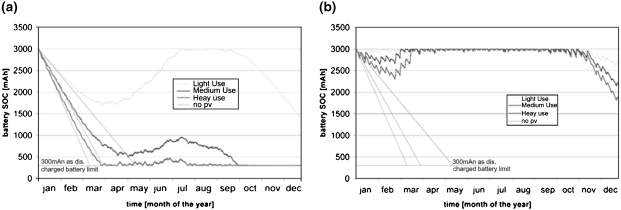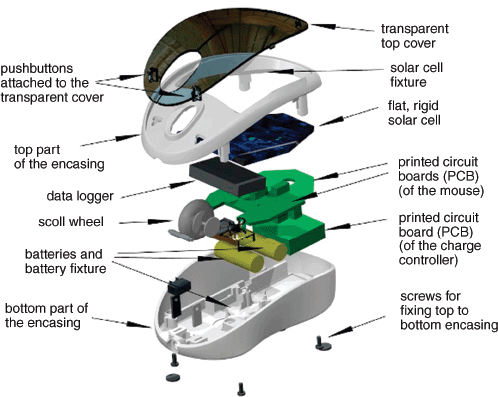E.2 Product Design Process
Exploratory studies were conducted to determine the kind of project and product the SPM idea would develop into. This so-called quick scan included market research (existing products, market segmentation, and corridor of price), user research (observational research, interviews, and focus groups), and rough energy balance calculations (charge generation of PV indoors, device charge demands, and typical use times). The quick scan and the preliminary energy balance estimations (discussed further in this case) indicated that the development of a wireless solar mouse would be feasible. At this stage, three obvious product concepts could be distinguished: (1) an SPM that is worry free, (2) an SPM that requires special user care, and (3) an SPM that has a larger surface area than traditional mice.
Ideally, the SPM would be energetically self-supporting, thus not requiring any special user care. This can only be achieved, however, if the SPM is only occasionally used (option 1). To guarantee 100% solar operation for medium- and heavy-use SPMs, they require pro-active “sunbathing” to recharge their batteries (option 2). An alternative is to increase the PV area (option 3). However, this inevitably leads to a mouse pad–sized product, which would not require special user care due to the sheer inconvenience of sunbathing a larger product. We decided to opt for option 2.
E.2.1 Focus Group Research
So-called focus group research, in which several potential users are interviewed qualitatively, allows a closer interpretation of user criteria related to device designs. Focus group research highlighted that the SPM's perceived quality is greatly influenced by the way PV cells are integrated in the encasing. Figure E.2.1 shows three mouse designs that were assessed by potential users. According to the focus group participants, the PV cell must follow the shape of the encasing. If this is not the case, PV cells are perceived as vulnerable and/or less reliable. This is a key issue, since the same focus group research pointed out that ergonomics is the most important criterion of a user, with organic, rounded shapes being perceived as most attractive. It thus also indicates that rectangular mice, such as that depicted in Figure E.2.1a, are not an option.
Figure E.2.1 Integration of various PV cell types using different encasing shapes and technologies, with (a) flat panel integration as part of an outer encasing; (b) integration of crystalline silicon cells connected in series; and (c) bent amorphous silicon cell integration

E.2.2 Energy Balance Scenarios
To estimate energy balances for the SPM, both the charge demand of the device and the charge generation potential of the solar cells to be incorporated need to be determined. Market research found commercial products' charge demands to vary by a factor of 4–5. The commercially available product with the lowest power demand at the time (end of 2005) was sold by Microsoft as the Intellimouse. Meanwhile, energetically more economic mice operating with a laser instead of a light-emitting diode (LED) have been introduced. The SPM product is based on Intellimouse electronics and consequently LED technology. Charge demand ranges can easily be calculated based on expected device use times of 4–27 hours of mouse motions per week (Percept Technology Labs, 2004). The Microsoft Intellimouse uses three energy management system (EMS) levels to minimize energy consumption. Additionally, battery runtime is increased by adapted LED intensity depending on the underlay material. Furthermore, the DC/DC converter provides the electronic circuitry of the mouse with sufficient voltage (3.5 V) with (primary) battery voltages as low as 0.6 V. However, the product is not equipped with a simple energy-saving on-off switch, but relies on “sleeping mode” activation.
The amount of PV-generated charge depends on the solar cell area, the effective solar cell efficiency, and the amount of available irradiation. Active solar cell area was initially estimated to be between 20 and 30 cm2, based on typical mouse product dimensions; the final product incorporates 28 cm2 of PV. As the “effective” PV efficiency depends on several factors (Reich et al., 2010a, 2011), we assumed overall 10% constant efficiency to reduce complexity (that is, neither irradiance intensity nor temperature-dependent PV performance is considered, and spectral effects are not accounted for). Consequently, the amount of PV-generated charge can be easily estimated based on irradiance time series. For this, we used hourly averaged, global horizontal irradiation measured in 2005 in de Bilt, the Netherlands. Lower irradiance levels indoors were accounted for by a simple attenuation factor of 0.05, which is similar to a constant daylight factor (DF) of 5%. When the SPM is sunbathed, available irradiance levels will be (much) larger. For this case, we assumed a constant DF of 60%, which implies a windowsill located in a south-facing room with direct sunlight access. During device use, PV power output is assumed to be zero, as the user's hand then covers the solar cell. Finally, PV-generated charge was assumed to be lowered by battery charge efficiency (90% constant), battery self-discharge (15% per month), and the efficiency of electronic circuitries (90% constant), which also provides maximum power point tracking (with 100% accuracy assumed). To deal with the many parameters, we developed a computer tool to simulate the energy flows in PV-powered consumer systems (Reich et al., 2010b).
A calculated battery state of charge (SOC) for a whole year is shown in Figure E.2.2, comparing computer mice with and without incorporated PV. The battery SOC of mice without incorporated PV is depicted in both figures by gray lines. For all calculated battery SOC, three different weekly use times of 4 h (light use), 18 h (medium use), and 27 h (heavy use) were assumed. In addition, a sunbathed SPM (Figure E.2.2b) is compared to a SPM that is not sunbathed (Figure E.2.2a). Note the influence users have by sunbathing the SPM. The batteries are almost fully charged during the period March–October for assumed sunbathing patterns, in which the SPM is exposed to 60% of global horizontal outdoor irradiation daily from 11:30 a.m. to 12:30 p.m. as well as during the entire weekend. Comparing both figures also shows the difficulties encountered when dimensioning components, as different optimal battery capacities are associated with each scenario. For the sunbathing scenario chosen here, the optimal battery capacity would be 1900, 1250, and 500 mAh for heavy, medium, and light device use, respectively (i.e., the minimum battery capacity required for granting year-round product operation on 100% PV-generated charge). However, when mice are not sunbathed, battery capacity will be sufficient for light use only. It would therefore be very helpful if typical charge yields related to sunbathing activity could be defined quantitatively. Unfortunately, this is rather difficult, due to varying irradiation conditions (e.g., direct or diffuse). We therefore decided to focus only upon the question of how long users are willing to proactively place their SPM at a specific indoor location, to harvest considerable higher “daylight” (diffuse irradiance) or direct sunlight, respectively.
Figure E.2.2 Battery state of charge for an SPM that (a) is not and (b) is sunbathed on a daily basis between 11:30 a.m. and 12:30 p.m. (weekdays) and during the whole weekend. Gray lines denote battery state of charge for mice without PV cells

E.2.3 Design Criteria
Based on the exploratory studies and energy balance estimations, we defined design criteria. First, the following energetic requirements were agreed upon:
- When fully charged, the SPM must allow 5 days of work without irradiation.
- The SPM must indicate when sunbathing is required (before the battery runs flat).
- The design should stimulate the user to “sunbathe” the SPM.
- The incorporated PV and charge storage unit should provide year-round product operation, if the mouse is “sunbathed” adequately.
- The user manual must clearly state how much “sunbathing” is required.
Regarding more general product functions, it was agreed upon that the SPM must be equipped with a scroll wheel and two push buttons, guarantee a product lifetime of at least 5 years, and be compliant with the restriction of the use of certain hazardous substances in electrical and electronic equipment (RoHS, 2002). The concept should also enable the manufacturing of prototypes at a later stage. The potential concepts should be evaluated as if the SPM was to be produced in a commercial setting. To allow for (theoretical) mass production, the individual components must be commercially available. Finally, users should perceive the SPM as a quality product, not as a gadget. The focus group investigations indicated users could perceive the SPM as a (high)-quality product based solely on design aesthetics. Therefore, only a single PV cell that follows the encasing's shape should be used, to avoid bad user perception of the SPM prototype design. Figure E.2.3 shows the various components of an SPM in accordance with the defined device criteria. The solar cell is, as depicted, flat and rigid, albeit the double-bent transparent cover and the encasing of the mouse lead to a “streamlined geometry” without any corners or edges.
Figure E.2.3 Exploded view of the SPM

